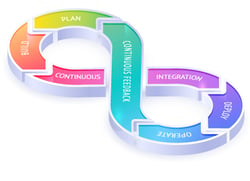The nature of a trend is that it's new, novel, and promoted across the industry, but is it worth implementing? The vast range of product complexity in manufacturing means that no two organizations will adopt the same process. Evaluating each trend and considering whether it's worthwhile for your company to test or ignore is important. Let's discuss some of the current trends in Agile product development for manufacturers of physical goods and whether they're worth considering for your teams.
Lean Manufacturing
 Lean principles, derived from the Toyota Production System (TPS), have been discussed in manufacturing since the 1970s. However, the idea continues to trend as Agile remains a focus for manufacturers. Lean principles are also used to inspire organizations across industries, from health care to government to manufacturing. The idea of lean focuses on minimizing waste and maximizing value and productivity.
Lean principles, derived from the Toyota Production System (TPS), have been discussed in manufacturing since the 1970s. However, the idea continues to trend as Agile remains a focus for manufacturers. Lean principles are also used to inspire organizations across industries, from health care to government to manufacturing. The idea of lean focuses on minimizing waste and maximizing value and productivity.
Agile guidelines for manufacturing often incorporate lean techniques to help streamline processes, reduce excess inventory, and improve efficiency at every level of development. Some of the key principles of lean manufacturing that organizations can consider using include:
- Continuous Improvement: Encouraging ongoing small changes to improve the development process and the products themselves.
- Respect for People: Involving and empowering employees to contribute ideas for improvement of the products and the development process.
- Just-in-Time (JIT) Production: JIT is a core principle of lean manufacturing, emphasizing producing goods exactly when needed and in the quantity required by the next process or customer. JIT minimizes inventory levels, reduces lead times, and eliminates storage costs.
- Value Stream Mapping: Analyzing and optimizing the steps in a process to eliminate waste.
- Kaizen: The concept of continuous improvement involving all employees.
Lean manufacturing seeks to create a more efficient, flexible, and responsive production system by eliminating non-value-added activities and focusing on delivering value to customers.
Flexible Manufacturing Systems (FMS)
 Meeting the needs and demands of consumers is a challenge, especially with increasing expectations for instant value. Manufacturing companies are presented with challenges in meeting a wide range of consumer demands at faster speeds than ever before. That's where Flexible Manufacturing Systems (FMS) come in. FMS enables rapid changeovers and reconfiguration of production lines to accommodate different products or variations as needed.
Meeting the needs and demands of consumers is a challenge, especially with increasing expectations for instant value. Manufacturing companies are presented with challenges in meeting a wide range of consumer demands at faster speeds than ever before. That's where Flexible Manufacturing Systems (FMS) come in. FMS enables rapid changeovers and reconfiguration of production lines to accommodate different products or variations as needed.
With an FMS design, companies can produce a wide variety of products efficiently and adapt to changes in product design or consumer demand with fewer wait times. The FMS combines several automated machines, including Computer Numerical Control (CNC) machines, robots, and material handling systems. This equipment combination, along with computer control and monitoring, creates a highly adaptable production environment with greater flexibility than before.
Agile manufacturers who want to implement an FMS must invest in flexible automation technologies and modular equipment that can be easily adapted to new requirements without lengthy retooling. This results in quick pivots, greater production flexibility, and faster launch times.
Rapid Prototyping and Iterative Design
 One of the tenets of Agile manufacturing is creating the minimum viable product (MVP) and rapidly testing iterations to develop the best product possible. Agile manufacturers use rapid prototyping techniques, such as 3D printing, to quickly create prototypes and iterate designs based on feedback. This allows for faster concept validation and reduces the time to market for new products.
One of the tenets of Agile manufacturing is creating the minimum viable product (MVP) and rapidly testing iterations to develop the best product possible. Agile manufacturers use rapid prototyping techniques, such as 3D printing, to quickly create prototypes and iterate designs based on feedback. This allows for faster concept validation and reduces the time to market for new products.
Adopting this strategy will require setting out expectations in the product development process. Your product managers, along with design and engineering leads, will need to be on board with this process. They'll also need to be in contact with other stakeholders to ensure testing and feedback happens effectively.
Your teams may also need new technology pieces and training on how to use them, especially if 3D printing is new to them. There's a high chance your teams already have experience, but it's up to your management to find out and determine what is needed.
Digital Twins and Simulation
Rapid prototyping has its benefits, but it's not always feasible to create several iterations of a complex product in full. That's where digital prototyping can help. Creating a virtual replica of physical products, processes, or systems is known as "digital twins." Building a digital twin allows manufacturers to simulate and optimize production without disrupting actual operations. Agile manufacturers can leverage digital twins for predictive maintenance, process optimization, and scenario analysis.
Even if your company has employees with experience in this technology, it's important to train everyone on the team to ensure the same processes are followed and expectations are met. Implementing digital twins and simulation into your product design process can help save resources, improve your products, and increase customer satisfaction.
Dynamic Product Roadmapping
 Implementing Agile trends into the product design, development, and production processes means you also need flexible product roadmapping tools to match. Creating dynamic product roadmaps means you have a product roadmap management system in play that allows for quick updates, shared information, automated alerts, and customizable views of the portfolio for all levels of oversight.
Implementing Agile trends into the product design, development, and production processes means you also need flexible product roadmapping tools to match. Creating dynamic product roadmaps means you have a product roadmap management system in play that allows for quick updates, shared information, automated alerts, and customizable views of the portfolio for all levels of oversight.
Gone are the days when your product teams created a roadmap and rarely altered it during production. Today's product roadmap technology reflects the Agile nature of the product development process with updated metrics, clear company goals, and detailed information at your fingertips.
Strategies for Overcoming Resistance to Change
As human beings, we don't always love change of every kind. If your organization is planning to introduce any changes by adopting these trends, you'll likely face some resistance. Here are some strategies to help you overcome organizational resistance to change.
Gain Leadership Buy-In: Making change happen in a large organization cannot happen without your leadership teams' buy-in. This doesn't mean your leadership team can veto executive decisions, but their input should be considered and valued. Once your leaders are on board, you'll face less resistance through your company.
Prioritize Education: Change is easier to accept when the reasons behind the change are explained. Start by educating your leaders on the goals behind the new direction to ensure they understand and can, in turn, educate their teams.
Invest in Training: If the change you plan to implement requires employees to learn a new system, you'll want to invest in training. Not only will your company adjust to the change quicker and faster, but your teams will also feel confident in the new systems and expectations.
Set Realistic Expectations: Change is never easy, even when you have company-wide support; that's why setting realistic expectations is essential. If you put too much pressure on your teams to adopt the changes in an unrealistic time frame, their support for the change will dwindle.
Change Management: You'll want to manage the change in your organization as you would any project with a timeline, scheduled reviews to check-in on progress, with a target goal for completion. It's not enough to announce change and expect it to happen. Managing the shift ensure it happens.
Product Roadmap Management Software for Agile Manufacturers
In conclusion, trends in Agile product development may appear enticing due to their novelty and widespread promotion, but their worthiness of implementation varies. Given the diverse range of product complexities in manufacturing, no single process fits all organizations. Having the right tools to manage your dynamic roadmaps is essential for whichever combination of trends you implement in your companies. Book your free demo to see how Gocious product roadmap management software can work for your teams.


